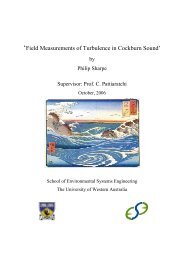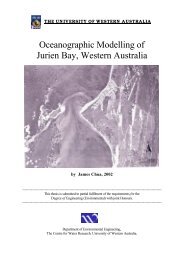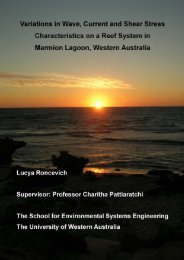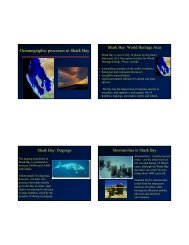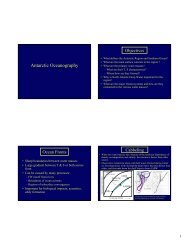Directional Waves in the Nearshore Coastal Region of Perth ...
Directional Waves in the Nearshore Coastal Region of Perth ...
Directional Waves in the Nearshore Coastal Region of Perth ...
You also want an ePaper? Increase the reach of your titles
YUMPU automatically turns print PDFs into web optimized ePapers that Google loves.
<strong>Directional</strong> waves <strong>in</strong> <strong>the</strong> nearshore coastal region <strong>of</strong> <strong>Perth</strong>, Western AustraliaHuey Jean Tan(a) Day 1: A low pressure trough extends <strong>in</strong> a generalnorth-south orientation <strong>in</strong>land <strong>of</strong> <strong>the</strong> west coast and ahigh pressure system is centred over <strong>the</strong> Indian Ocean.The typical w<strong>in</strong>d pr<strong>of</strong>ile shows a moderatesou<strong>the</strong>asterly w<strong>in</strong>d <strong>in</strong> <strong>the</strong> early morn<strong>in</strong>g, veer<strong>in</strong>g to <strong>the</strong>southwest and streng<strong>the</strong>n<strong>in</strong>g by late morn<strong>in</strong>g. W<strong>in</strong>dwill gradually tend sou<strong>the</strong>ast and moderate overnight.The strongest sea breezes <strong>in</strong> <strong>Perth</strong> result from thispattern.(b) Day 2: The low pressure trough has progressedfur<strong>the</strong>r <strong>in</strong>land and <strong>the</strong> high over <strong>the</strong> Indian Ocean iscloser. W<strong>in</strong>d pattern is similar to Day 1, although seabreeze may arrive later and a little weaker. The w<strong>in</strong>dmay turn to a gusty easterly overnight.(c) Day 3: The high pressure cell has progressed fur<strong>the</strong>reast and is now located <strong>of</strong>f <strong>the</strong> south coast andproduc<strong>in</strong>g a hot easterly flow over WA. A fresh tostrong easterly w<strong>in</strong>d early <strong>in</strong> <strong>the</strong> morn<strong>in</strong>g will moderatedur<strong>in</strong>g <strong>the</strong> day as <strong>the</strong> temperature rises. A weak seabreeze may arrive late <strong>in</strong> <strong>the</strong> afternoon, but <strong>the</strong> w<strong>in</strong>d islikely to return to <strong>the</strong> east and freshen dur<strong>in</strong>g even<strong>in</strong>g.On some days <strong>the</strong>re will not be a sea breeze and <strong>the</strong>(d) Day 4: The formation <strong>of</strong> a low pressure trough along<strong>the</strong> west coast is due to <strong>the</strong> temperature differencebetween <strong>the</strong> land and sea surfaces. Ano<strong>the</strong>r high islocated over <strong>the</strong> Indian Ocean. W<strong>in</strong>ds may rema<strong>in</strong> from<strong>the</strong> nor<strong>the</strong>ast until mid-afternoon when a moderate seabreeze is likely to develop.Figure 2.8: A typical summer sequence for <strong>Perth</strong> (from BOM 1993)22 Literature Review



